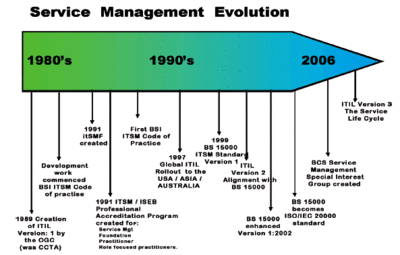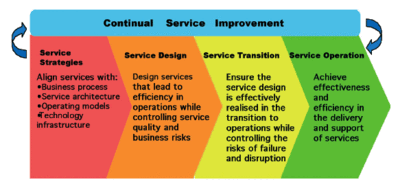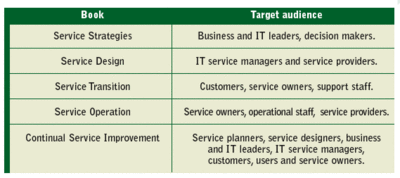IT evolution within industry has progressed slowly since the late 1980s; the focus for customer service was just starting, and new software applications were being released to support business needs. However at that time often only minimal consideration was given to the impact these releases would have on existing hardware, infrastructure and people.
There was also the added complication of there being no true way of measuring the return on investment (RoI) of these new IT solutions, nor the total cost of ownership (TCO), a substantial element of which is attributable to live operational support.
Minimal consideration was paid to producing a baseline or benchmark of these aspects across organisations or industry sectors to obtain understanding of how to achieve efficiencies.
To help rectify this situation the UK Government's Central Computer and Telecommunications Agency (CCTA), now subsumed within the Office of Government Commerce (OCG), introduced a new documentation set called the IT Infrastructure Library, (ITIL®) to capture best practices for UK government departments to implement.
Over the last 17 years, ITIL® has evolved and been adopted by both the public sector and commercial organisations. In parallel the British Standards Institution developed a Code of Practice and British Standard for IT Service Management.
This standard was fast-tracked to become the International Standard ISO/IEC 20000 in December 2005 and organisations in around 20 countries have already achieved certification.

Where is IT service management to date?
IT has changed extensively since the late 1980s and the typical challenges for an IT service department / service supplier have changed in this time. Here are some of the typical challenges today:
(i). business dependence on IT services;
(ii). keeping the services running;
(iii). managing the risk and complexity of IT;
(iv). optimising costs;
(v). legal/regulatory compliance;
(vi). sourcing and managing services across the supply chain.
The business environment challenge today is that of rapid change. Many projects fail trying to deliver that change. Over the years a poor perception of IT projects has emerged.
A study performed on 13,522 IT projects showed that only 16 per cent of all IT projects were delivered on time and to budget, 31 per cent were cancelled outright and the remaining 53 per cent had worrying delivery failures, sometimes as significant as 200 per cent behind schedule or cost.
Furthermore poor perception felt by the business reflects how IT fails to deliver IT services that support critical business services as '80 per cent of unplanned IT system downtime is due to people and processes.'
By implementing ITIL® best practice processes and developing IT service management professionals, organisation can address these challenges.
The initial IT service management awareness and benefits found by the new ITSM communities were discovered in an itSMF survey - 70 per cent of organisations achieved tangible benefits from implementing IT service management best practices.
The IT service management elements represent the life cycle stage that consumes approximately 80 per cent of the total IT spend, hence the benefits often exceeded expectations when ITIL® best practices were adopted.
Other benefits found were:
- cost of service desk calls down 30%;
- 85% resolution at first point of contact;
- 50% reduction in new product introduction cycle;
- delivery of services focused on the business and customer needs;
- 20% reduction in operational costs through proactive problem management;
- creating a competitive advantage.
Within the UK, the BCS now has an IT Service Management Specialist Group (SMSG) who aims to provide an affordable informal forum for all BCS members and service management practitioners to discuss service management benefits, issues, innovation, best practice, products and experiences, and to act as a resource for personal and professional development within the service management community.
Other objectives include to:
- provide a focus for the independent, informal discussion and exchange of ideas on service management;
- act as a centre of knowledge and information within the BCS;
- promote the application of service management best practice;
- promote service management in cooperation with other specialist groups and the BCS membership;
- encourage professional development for members in service management areas;
- promote the role of service management so that other groups embrace it as part of their thinking, business, projects, technical teams, developers, supply chain and others.
Where are we going next? The holistic service life cycle approach
Running global, business-critical services is like keeping a fleet of aeroplanes in the air - the IT industry needs to be more professional about building in quality across the supply chain. Imagine forgetting to train the pilots in a new type of aeroplane and taking passengers out without the full testing cycle being completed.
Providing IT-related services is one of the fastest-growing sectors of the economy, producing value not just for the customers but economic returns for the service providers. Delivering quality services cost-effectively requires competent professionals to operate the supporting systems and processes.
Why then do projects tend to focus on technology? We need far more focus on developing the non-technological aspects, for example, developing competent people to run the service, testing new versions of plans and processes, updating knowledge bases and improving documentation and configuration management.
Many organisations have adopted software or application life cycle management best practices to improve business and IT alignment. However even this is not enough. All too frequently development teams focus on delivering the functional requirements and changes to the service operational requirements are forgotten or pushed to a lower priority.

In future, comprehensive service life cycle management (SLCM) will be vital as businesses and customers demand improved quality, value and adaptability with faster turnaround from IT providers.
Currently underway, the OGC, itSMF international and examination institutes are working together to improve the content of the publications and qualifications.
This programme, referred to as ITIL® Refresh, aims to improve the usefulness and applicability of ITIL® to support business need, and to clarify the link between employment of the best practices and business benefits using pragmatic service management approaches.
Over 6,000 views have been captured from consultations with all stakeholders in the global ITIL® community. These views have all been incorporated into the plans for creating the new ITIL® Version 3 Refresh model.
This new version of ITIL® will adopt a robust 'cradle to grave' service life cycle, taking into account the enterprise business, strategic, tactical and operational elements of a service life cycle.
The BCS SMSG has a representative on the ITIL® Refresh Advisory Group (IAG) to review draft ITIL® Refresh documents and act as one of the author mentors. The SMSG provides the means of discussing issues to provide feedback to the IAG forum.
ITIL® Version 3: programme objectives and deliverables
The ITIL® Refresh programme is centrally coordinated by the The Stationery Office (TSO), who aims to ensure that key service management information and publications are managed professionally to maximise efficiency, quality, impact and value.
Therefore the ITIL® Refresh programme will result in a new set of core books, together with a selection of free web-based topical support materials made available in the form of case studies, checklists and process maps. These will be developed frequently during the Refresh programme and as industry demand changes.
As an author of the new ITIL® Version 3 books, the aim is to ensure that all readers will obtain a complete understanding of the role of service management. The core books within ITIL® Version 3 are outlined in Table 1 below.

Development of the IT Service Management Professional
A comprehensive range of IT service management professional accreditation has been developed since the late 1980s by the UK BCS Information Systems Examination Board (ISEB) and by the Netherlands IT Examination Institute (EXIN).The IT service management qualifications awarded to IT professionals has grown to 73,179 over the last 15 years. These qualifications are designed to be both accessible and relevant.
They cover all major areas of IT service management including foundation, practitioner and manager levels of certification. The 73,179 total figure in ITSM professionals gaining these professional qualifications is made up of: Foundation Level - 64,410; Practitioner Level - 348; Managers Level - 8,421.
Coupled to this the UK BCS organisation has facilities to enable professional individuals to join the BCS SMSG and actively contribute to the future of service management best practice as well as contributing to their professional development.

















